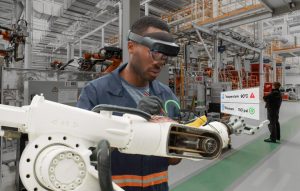What comes to your mind first when we talk about the metaverse or a virtual reality with avatars? Obviously, science fiction movies like Ready Player One, the Matrix (to some extent), Gamer, Wall-E, to name a few, are the ones that top the list. Then, games like Second Life, Fortnite and Age of Conan follow.
These are all fictional and a part of the entertainment world we’re talking about. However, looking at the current pandemic scenarios, the future isn’t far where we use the metaverse in our daily routine.
Gartner expects that by 2026, 25% of people will spend at least one hour a day in the metaverse for work, shopping, education, social media and/or entertainment.
If this statistic is anywhere close to becoming a reality, we should all get familiarized with the concept of a metaverse and its impact.
What is the metaverse?
Meta, meaning beyond and verse, meaning universe – when we combine them, we get the metaverse. It is an immersive digital environment that allows people to socialize as avatars. It is device-independent and is not owned by a single vendor as it is more of a technological concept rather than a product. Think of it as a next version of the Internet where rather than just looking at it, people live in it, not literally though. The metaverse is a shared virtual world, where lands, buildings, avatars and other physical entities can be bought and sold often using cryptocurrency.
To better understand the metaverse, there are a couple of aspects that needs to be explained too:
Virtual economy – often referred to as synthetic economy is an economy that exists in a virtual world where users can create, buy or sell virtual goods using crypto currency.
NFTs – nonfungible tokens (NFTs) are exclusive blockchain-based digital assets like digital art or music and often consist of tokenized physical assets like houses or cars.
It seems fascinating, but is it really? Let’s dig deeper into it and find out.
Recent popularity of the metaverse
This rise in the popularity of the metaverse can offer so many opportunities for technology companies to create interoperable metaverses. In a more idealistic vision of the metaverse, this will not only allow users to create their avatars and interact with one another, but will also allow companies to create digital assets and sell them in the virtual world. It will be like the ‘Inception’ of the metaverse.
In the current world, most platforms that leverage the metaverse provide virtual identities, avatars and goods that are tied to a specific platform. However, in a futuristic scenario, the metaverse might allow you to create a persona that you can take everywhere and link with other platforms. There might also be a possibility of several metaverses to be linked, just like many social media platforms currently are. To think further, as of today, it isn’t possible for an avatar in Second Life to interact with an avatar in The Fortnite. Although, the possibility of this happening is not inconsiderable.
After Facebook announced its rebrand to Meta in October 2021, the term spiked 25x in popularity.
Remember when Facebook was just a website/app used to connect with people at different locations? Well, now it seems like this was ages ago. Just as Facebook incorporated several features including e-commerce, Facebook is no longer viewed as just a social media app. Facebook’s vision is way beyond in creating a virtual world where users can simply swipe through digital wardrobe to buy and sell virtual clothes. Facebook really wants to promote selling virtual assets, and that’s where Meta comes into the picture. Although, to create a metaverse, there are several aspects to be considered, including technologies, infrastructure, budget and security, to mention a few.
Technologies that make the metaverse
The metaverse is a complex virtual environment that relies on several distinct layers. Not only hardware but software and infrastructure play an important role too. It comprises of the following elements:
Infrastructure – Connectivity technologies like 5G, Wi-Fi, cloud and GPUs
Hardware – VR headsets, AR glasses and mobile devices
Spatial computing – 3D visualization and modelling frameworks
Creator economy – Designing tools, digital assets and e-commerce establishments
Software – Blockchain, artificial intelligence, edge computing, mixed reality (MR) mobile applications, etc.
Immersive 3D environments require a lot of computing power to generate quality results. Also, security is another major concern associated with the adoption of the metaverse. Hence, there are various factors that companies should consider before jumping head-first into investing in the metaverse.
While this all might sound theoretical, a few of the leading organizations have already moved ahead and have adopted the metaverse into their business.
Real-life uses of the metaverse
The surging fame of the metaverse has prompted many companies to venture into creating their own virtual worlds along with their own digital properties and assets. There are several companies from the following sectors that are already investing in the technology:
E-commerce
Walmart is in talks to be venturing into the metaverse with plans to create its own cryptocurrency and collections of NFTs.
Gaming
Companies like Epic, Funcom, Linden Lab, Sky Mavis who have successfully launched avatar-based online gaming are looking to explore the metaverse in detail to increase the fun element in their games.
Conferences/meetings/concerts
Metaverse Studio offers AR classrooms that allow educators and students to create and participate in project-based learning with virtual environment. In September 2021, millions of people watched the singer Ariana Grande virtually perform in Fortnite. Not to mention, Facebook, that recently rebranded itself as Meta, is providing a virtual space for social gathering. AltSpace is another such example that provides a virtual conferencing platform that works with various platforms including Apple OS and Windows.
Real estate
Companies like Decentraland and The Sandbox provides users a virtual space to buy and sell land, estates, properties and wearable for their avatars. A patch of virtual real estate in Decentraland sold for $2.4 million worth of crypto while a plot of virtual land in The Sandbox fetched a hefty price of $4.3 million.
The metaverse no longer seems to be in its infancy stage. Although it requires in-depth knowledge about the hardware and software involved, it seems that companies are looking to adopt the technology to stay ahead of the competition.
Future of the metaverse
The future seems bright for the metaverse. It’s no longer a science fiction concept. The activities that currently take place in real world might eventually take place in a metaverse in a massive amount, such as:
- Buying and selling clothes and accessories for online avatars
- Purchasing digital land
- Constructing virtual homes/offices
- Social gatherings/events/concerts
- Virtual malls, leading to immersive commerce
- Virtual classroom for immersive learning
- Buying digital art, collectibles and assets (NFTs)
- Onboarding employees, customer service, sales and other business interactions via digital avatars
The list is endless and can go to infinite possibilities. In true sense, we are yet to venture into the metaverse of madness. The future isn’t far when the technology will be used like we use the Internet in these days. At Softweb Solutions, we are always at the forefront, looking to explore advancements in the field of AR, VR and XR. We have not only adopted these technologies to help businesses that are thriving for growth, but we are also looking forward to see the enhancements in the virtual reality world. Considering the metaverse, we are excited to learn more about it – the good, the bad and the ugly.







